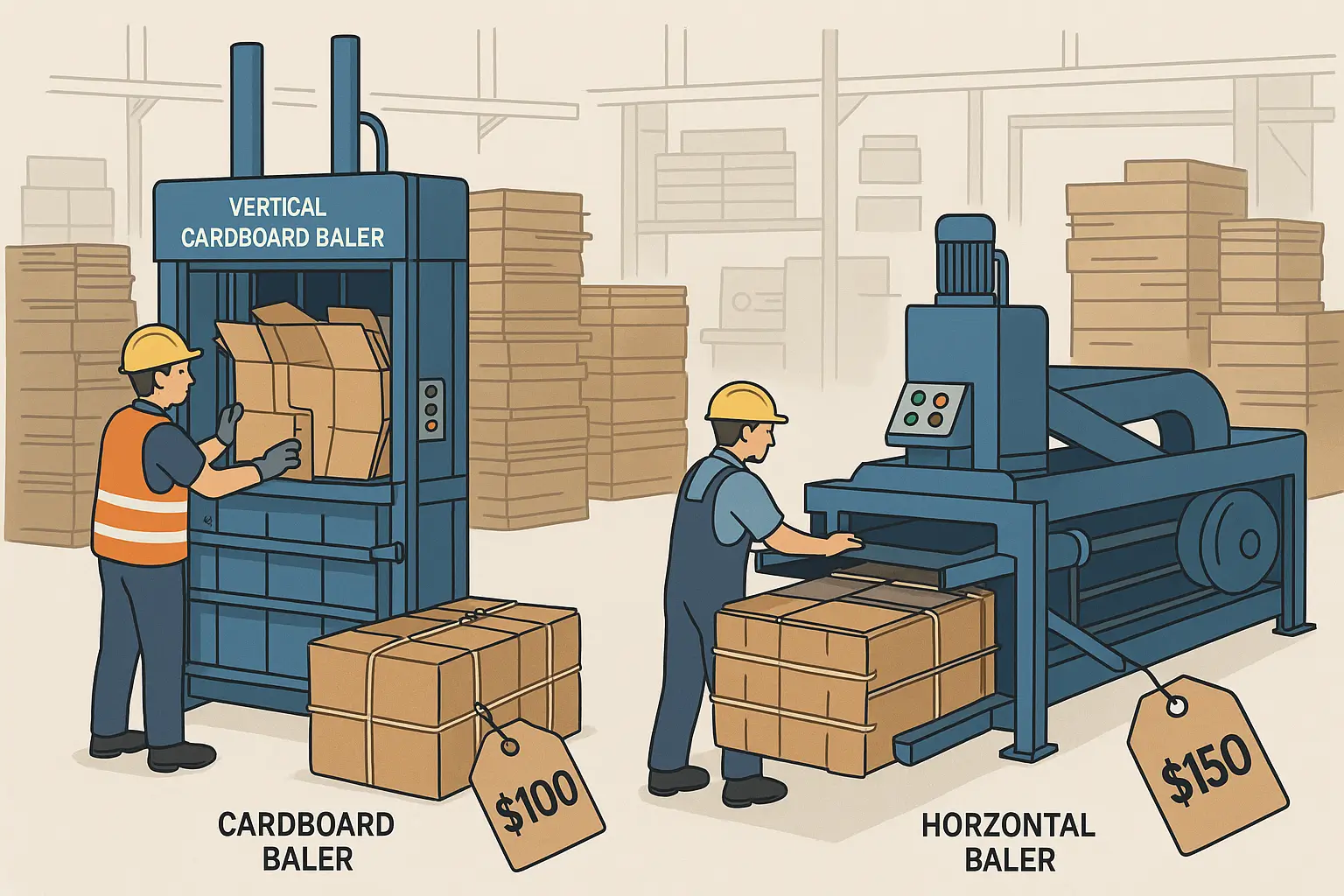Main Takeaway: Investing in a cardboard baler typically requires an upfront expense ranging from approximately $3,000 for basic vertical models to over $100,000 for fully automated, high-capacity horizontal balers. The optimal choice hinges on waste volume, available space, budget, and desired level of automation—balancing initial purchase price against long-term operational savings.
1. Types of Cardboard Balers and Their Price Ranges
Cardboard balers fall into two primary categories: vertical balers and horizontal balers. Each category spans a spectrum from entry-level, manual units to high-end, fully automatic systems.
1.1 Vertical Balers
Vertical balers are compact, front-loading machines that compress cardboard vertically. They are well suited for small- to medium-volume operations and limited floor space.
| Model Category | New Price Range | Used Price Range | Typical Bale Weight |
|---|---|---|---|
| Light-Duty Vertical | $3,000 – $8,000 | $5,000 – $20,000 | 100–300 kg |
| Medium Vertical | $10,000 – $25,000 | $15,000 – $25,000 | 200–400 kg |
| Heavy-Duty Vertical | $20,000 – $50,000 | $20,000 – $30,000 | 300–500 kg |
Vertical balers offer the lowest initial investment. Their simple hydraulics and manual bale-tying translate to purchase prices as low as $3,000 and rarely exceed $50,000 for heavy-duty models. Used vertical balers can be found from $5,000.
Key Advantages:
- Compact footprint
- Lower capital expenditure
- Simpler maintenance routines
Considerations:
- Higher labor costs for manual feeding and tying
- Lower bale density and weight versus horizontal units
- Slower throughput for high-volume applications
1.2 Horizontal Balers
Horizontal balers are designed for continuous loading, often via conveyor or forklift, and compress cardboard horizontally. They excel in high-throughput environments such as distribution centers and recycling facilities.
| Model Category | New Price Range | Used Price Range | Typical Bale Weight |
|---|---|---|---|
| Semi-Automatic Horizontal | $10,000 – $25,000 | $55,000 – $90,000 | 300–600 kg |
| Mid-Range Automatic | $25,000 – $50,000 | $95,000 – $200,000 | 400–800 kg |
| Fully Automatic | $50,000 – $150,000+ | $125,000 – $350,000 | 500–1,000 kg+ |
Horizontal balers’ purchase prices broadly stretch from around $10,000 for entry-level, semi-automatic models to over $150,000 for large, fully automated systems. Used industrial horizontal balers commonly start at $50,000 and can exceed $200,000 for top-end units.
Key Advantages:
- High throughput and continuous operation
- Automated feeding, tying, and ejection reduce labor
- Denser bales lower transportation and disposal costs
Considerations:
- Significant capital outlay
- Larger footprint and more complex maintenance
- Requires conveyor or forklift infrastructure
2. Factors Influencing Cardboard Baler Cost
2.1 Capacity and Throughput
- Hourly Baling Capacity: Machines rated for under 1 ton/hour are generally vertical units under $25,000, while capacities above 1 ton/hour necessitate horizontal balers priced above $30,000.
- Bale Weight & Density: Heavier, denser bales require more robust hydraulics and larger cylinders, increasing material and manufacturing costs.
2.2 Level of Automation
- Manual vs. Semi-Automatic vs. Fully Automatic: Each increment in automation (auto-feeding, auto-tying, programmable controls) can add 20–40% to base machine price. Fully automatic horizontal balers command premiums upwards of $100,000 for high throughput lines.
2.3 Build Quality and Brand
- Materials: High-quality steel frames, industrial-grade hydraulic pumps, and abrasion-resistant components extend lifespan but increase cost.
- Brand and Warranty: Established manufacturers often charge higher prices but offer longer warranties and service networks.
2.4 Installation and Ancillary Costs
- Site Preparation: Concrete flooring, electrical upgrades (13 A single-phase vs. 3 phase lines), and safety guarding must be budgeted separately.
- Freight and Assembly: Shipping heavy machinery and professional installation can add 10–15% to delivered cost.
2.5 Operating and Maintenance Expenses
- Energy Usage: Hydraulics and conveyors consume electricity; annual energy costs can range from $1,000 – $3,000.
- Consumables: Bale wire or strapping costs vary by gauge and volume; average annual expense ~$500–$1,500.
- Preventive Maintenance: Scheduled services, hydraulic fluid changes, and wear-part replacement should be estimated at 5–10% of purchase price per year.
3. New vs. Used Baler Investment
3.1 Benefits of Purchasing New
- Latest Technology: Improved automation, safety features, and energy efficiency.
- Full Warranty Coverage: Typically 12–24 months on parts and labor.
- Customization: Tailor machine to specific site requirements and waste streams.
3.2 Benefits of Purchasing Used
- Lower Capital Outlay: Used balers can cost 30–50% less than new equivalents.
- Faster Availability: Immediate deployment for urgent needs.
- Depreciation: Minimal further depreciation compared to new purchases.
3.3 Leasing and Rental Options
- Leasing Agreements: Spread investment over 1–5 years, often at 5–10% interest. Preserves working capital.
- Short-Term Rentals: Weekly rates (e.g., £16/week for UK vertical balers) include service and training, ideal for temporary projects.
4. Cost–Benefit Considerations and Return on Investment
A comprehensive cost–benefit analysis should weigh:
- Waste Disposal Savings: Baled cardboard can net recycling rebates; reduced bin volumes lower dumpster fees by up to 75%.
- Labor Efficiency Gains: Automation can free 1–2 full-time equivalents previously assigned to manual carton flattening.
- Transportation Optimization: Denser bales mean fewer truckloads and lower per-ton shipping costs.
- Revenue from Recyclables: High-quality bales command better prices per ton; typical cardboard bale rates range from $50 to $100 per ton depending on local markets.
Example ROI Calculation:
- Purchase a mid-range semi-automatic horizontal baler for $40,000
- Annual savings: $10,000 in labor + $5,000 in disposal fees + $3,000 in transport
- Net annual benefit: $18,000
- Payback period: ~2.2 years
5. Regional Pricing Variations
United States
- Vertical balers: $5,000–$25,000 new; $5,000–$20,000 used
- Horizontal balers: $15,000–$60,000 new; $50,000–$200,000 used
Europe
- Entry-level vertical balers from €1,095 (≈ $1,200) to €6,000 (≈ $6,500)
- Large horizontal systems from €9,499 (≈ $10,000) upwards of €60,000 (≈ $65,000)
Australia
- Small vertical balers from AUD 3,000 (≈ $1,900) to $8,000
- Large horizontal balers above AUD 30,000 (≈ $19,000)
6. Making the Right Choice
When selecting a cardboard baler, consider the following sequence:
- Assess Waste Volume: Estimate daily or weekly cardboard tonnage and peak loads.
- Evaluate Space Constraints: Verify floor space and ceiling height for each baler type.
- Define Automation Needs: Balance labor savings against upfront automation cost.
- Set Budget Range: Factor total installed cost, including power upgrades and training.
- Plan for Maintenance: Secure service contracts and parts availability.
- Calculate ROI: Incorporate cost savings, rebate potential, and resale value.
For small businesses with limited space and low volumes, a vertical baler offers an affordable entry starting near $3,000. Medium-to-large operations processing over 1 ton/day should prioritize horizontal balers to maximize throughput and labor efficiency, with investment levels from $15,000 upwards depending on automation.
Conclusion
The price of a cardboard baler is highly contingent on its design, capacity, automation, and brand. Entry-level vertical balers can cost as little as $3,000, while fully automatic, high-capacity horizontal balers may exceed $100,000. Factoring in operating costs, maintenance, and potential savings from reduced disposal fees and recyclables revenue, the right baler can achieve payback within 2–3 years for many businesses. A thorough evaluation of waste volumes, space, labor, and budget is essential to identify the optimal solution that balances upfront cost with long-term efficiency gains.



Leave a Reply